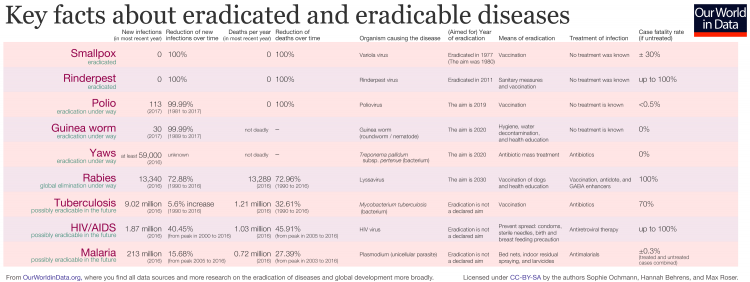The eradication of a disease refers to the permanent and global reduction of infections to zero. We wrote a companion blog post to explain what makes a disease eradicable here.
The good news is that the world has already eradicated two diseases. In 1980, the World Health Organization (WHO) declared Smallpox eradicated and in 2011, the World Organization for Animal Health (OIE) declared Rinderpest (a disease which only affected animals) eradicated. We discuss both diseases in our full entry on the Eradication of Diseases but also have a separate entry dedicated to Smallpox. Eradicable diseases that are expected to be eradicated next — Polio, Guinea worm and Yaws — are also discussed in our entry in greater detail.
So where does the world stand in its fight to eradicate these infectious diseases?
The chart below displays the annual number of cases from diseases that we hope to eradicate.1 The default setting below shows the number of cases globally. But by clicking on the “Change country” function on the bottom left of the chart it is possible to see the number of cases for any country of the world.
Polio and Guinea worm are the diseases that have the best chances of being eradicated next. The number of cases of both have decreased dramatically over the last 35 years. In 2016, only 46 new paralytic polio cases were recorded and the wild poliovirus was in circulation in only two countries: Afghanistan and Pakistan. Guinea worm, or dracunculiasis, has been driven back even further. 2017 saw only 25 new infections worldwide, concentrated in the last two endemic countries: Chad and Ethiopia.
The story of rabies and yaws is more complicated. Even though rabies infections have steadily declined from an estimated 49,000 cases in 1990 to 13,000 in 2016, its reservoir in wild bats means elimination rather than eradication needs to be aimed for first (see our entry’s section on rabies for more detail). Yaws cases are also declining but poor data availability makes the true extent of this decline harder to assess. Because data is very patchy, we cannot know for sure what progress we have made on reducing yaws’ disease burden. For instance, in our interactive map on yaws the endemicity status is unknown for all countries colored in yellow.
To compare these diseases, with respect to their disease burden, the means that exist against them or the progress we have made at reducing their case numbers, we have put together a summary table below. [Clicking on the table will open it in higher-resolution]. For comparison we have also included the three most lethal infectious diseases — Tuberculosis, HIV/AIDS and Malaria — however these are currently classified as non-eradicable. Although all are infectious diseases, the variety of pathogens (the disease-causing organisms), prevention options and treatments is striking. Even the case-fatality rates — the likelihood with which an untreated infection will lead to death — range from zero to one hundred percent.

So, can the world eradicate another disease? We are certainly close.
Two diseases have already been eradicated – smallpox in 1980 and Rinderpest in 2011. There are now a number of diseases for which eradication seems possible. The number of polio and Guinea worm cases have already been driven back so substantially that with continued effort, their eradication in the next years is within reach. Where the fight against infectious disease might take humanity after that is hard to foresee. If we start measuring yaws’ disease burden accurately or if we eliminate dog-transmitted rabies, we might be able to make these diseases history soon, too. And if science uncovers new measures, we might even be able to work towards the eradication of diseases such as tuberculosis, HIV/AIDS, and malaria, that currently still kill hundreds of thousands of people around the world.